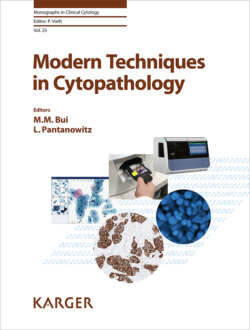Читать книгу Modern Techniques in Cytopathology - Группа авторов - Страница 13
На сайте Литреса книга снята с продажи.
Equipment
ОглавлениеFor a cytologist with an active FNA service, very little additional equipment is required when expanding their service to USFNA. There are numerous US machines available at various price points and features. Choice of a portable or floor model depends on personal preference. For USFNA of superficial masses, a linear high-frequency transducer is required. A small transducer footprint will allow for easier sampling of masses in the head and neck region. Unless a specialized feature such as elastography is desired, almost any modern US will meet the needs for a cytologist doing USFNA. When selecting an US machine, it is important that the buyer is comfortable with the image quality and ease of the user-machine interface. It is important to not only consider the purchase price of the unit, but also the warranty, cost of service contracts, use of a loaner unit if repair is required, and amount of time offered to train personnel in the use and setup of the machine.
The procedure room requires a patient procedure table (Fig. 1). This can range from a simple bed to a hydraulic procedure table. It is helpful to have a bed that has the capability to raise or lower the head so that the patient can be sitting, semi-recumbent, or flat. A table that can be lowered to 20–24" from the floor helps enable the transfer of patients with poor mobility. A pillow is needed for neck extension for thyroid biopsies. Bolsters for stabilizing patients when rolled onto their side and for placement under their knees to relieve pressure in the lower back are also helpful and appreciated by patients. It is very useful to setup a second monitor projecting the US image on a screen on the opposite side of the bed from the US monitor. This allows for easier setup for biopsy needle guidance.
Consumable items include US probe covers, choice of skin preparation (alcohol, betadine), anesthesia options, US gel, needles, and syringes. Probe covers come in a variety of styles. Skin preparation can be done with alcohol, betadine, or another cleansing agent. Anesthesia ranges from none to cutaneous preparations to injectables (Fig. 2). Needle gauge choice is dependent on the site being sampled, vascularity of the mass, the patient’s coagulation status, type of lesion sampled, and personal preference. Slip-tip syringes are recommended over luer-lock syringes so that the needle can easily and quickly be removed from the syringe, allowing for more rapid smear preparation and less chance for smear artifacts. Standard needles used for drawing blood are sufficient for aspiration biopsies. It is helpful to have a variety of needle gauges and lengths available. This allows the aspirating physician to choose a needle gauge based on the lesion being sampled, patient coagulation status, and Doppler vascularity of the mass. Use of a syringe holder (gun) is at the discretion of the aspirating physician; several styles are commercially available. A needle-only technique can be used to sample many masses. Some clinicians like using an adaptor between the needle and the syringe so that the needle-only technique can be used for needle placement, while an assistant can apply suction on an attached syringe.
Fig. 2. Cutaneous anesthesia options.
